

Supplement F2: The Chemistry of Amino, Nitroso, Nitro and Related Groups.
Edited by Saul Patai Copyright 1996 John Wiley & Sons, Ltd.
ISBN: 0-471-95171-4
CHAPTER 12
Advances in the chemistry of amino and nitro compounds
G. V. BOYD
Department of Organic Chemistry, The Hebrew University of Jerusalem, Jerusalem 91904, Israel
Fax: 972-2-658-5345; e-mail: EVA@BATATA.HUJI.AC.IL
I. INTRODUCTION . . . . . . . . . . . . . . . . . . . . . . . . . . . . . . . . . . . . . . |
534 |
|
II. AMINO COMPOUNDS . . . . . . . . . . . . . . . . . . . . . . . . . . . . . . . . . . |
534 |
|
A. Synthesis of Amino Compounds . . . . . . . . . . . . . . . . . . . . . . . . . . |
534 |
|
1. |
By reduction . . . . . . . . . . . . . . . . . . . . . . . . . . . . . . . . . . . . . |
534 |
|
a. Reduction of nitro compounds . . . . . . . . . . . . . . . . . . . . . . . |
534 |
|
b. Reduction of hydroxylamines, oximes, nitrones, etc. . . . . . . . . . |
534 |
|
c. Reduction of amides and cyanides . . . . . . . . . . . . . . . . . . . . |
536 |
|
d. Reduction of azides . . . . . . . . . . . . . . . . . . . . . . . . . . . . . . |
537 |
2. |
By alkylation and arylation of amines and azides . . . . . . . . . . . . . |
538 |
3. |
By modifications of the Gabriel synthesis . . . . . . . . . . . . . . . . . . |
540 |
4. |
From alcohols . . . . . . . . . . . . . . . . . . . . . . . . . . . . . . . . . . . . |
542 |
5. |
From epoxides, aziridines and oxetanes . . . . . . . . . . . . . . . . . . . |
543 |
6. |
From imines . . . . . . . . . . . . . . . . . . . . . . . . . . . . . . . . . . . . . |
545 |
7. |
By electrophilic amination . . . . . . . . . . . . . . . . . . . . . . . . . . . . |
550 |
8. |
+ |
553 |
Via >N C< synthons . . . . . . . . . . . . . . . . . . . . . . . . . . . . . . |
||
9. |
By oxidative amination . . . . . . . . . . . . . . . . . . . . . . . . . . . . . . |
560 |
10. |
By photoamination . . . . . . . . . . . . . . . . . . . . . . . . . . . . . . . . |
561 |
11. |
By reductive alkylation . . . . . . . . . . . . . . . . . . . . . . . . . . . . . . |
562 |
12. |
By means of organoboron compounds . . . . . . . . . . . . . . . . . . . . |
564 |
13. |
Synthesis of olefinic and acetylenic amines . . . . . . . . . . . . . . . . . |
567 |
14. |
By miscellaneous methods . . . . . . . . . . . . . . . . . . . . . . . . . . . |
577 |
B. Reactions of Amino Compounds . . . . . . . . . . . . . . . . . . . . . . . . . . |
578 |
|
1. |
Oxidation and dehydrogenation . . . . . . . . . . . . . . . . . . . . . . . . |
578 |
2. |
Dealkylation . . . . . . . . . . . . . . . . . . . . . . . . . . . . . . . . . . . . . |
581 |
3. |
Alkylation, arylation, etc. . . . . . . . . . . . . . . . . . . . . . . . . . . . . |
583 |
533

534 |
G. V. Boyd |
|
4. |
Amination of olefins . . . . . . . . . . . . . . . . . . . . . . . . . . . . . . . |
587 |
5. |
Formation of enamines . . . . . . . . . . . . . . . . . . . . . . . . . . . . . . |
588 |
6. |
Formation of amides etc. . . . . . . . . . . . . . . . . . . . . . . . . . . . . |
590 |
7. |
Protection of amines . . . . . . . . . . . . . . . . . . . . . . . . . . . . . . . |
594 |
8. |
Formation of carbamates, ureas, isocyanates, etc. . . . . . . . . . . . . . |
595 |
9. |
Cyclization reactions . . . . . . . . . . . . . . . . . . . . . . . . . . . . . . . |
597 |
10. |
Formation of aminyl radicals . . . . . . . . . . . . . . . . . . . . . . . . . . |
599 |
11. |
Miscellaneous reactions . . . . . . . . . . . . . . . . . . . . . . . . . . . . . |
601 |
III. NITRO COMPOUNDS . . . . . . . . . . . . . . . . . . . . . . . . . . . . . . . . . . . |
604 |
|
A. Synthesis . . . . . . . . . . . . . . . . . . . . . . . . . . . . . . . . . . . . . . . . . . |
604 |
|
B. Reactions . . . . . . . . . . . . . . . . . . . . . . . . . . . . . . . . . . . . . . . . . |
607 |
|
1. |
Formation of oximes, nitrones, hydroxylamines, amines, etc. . . . . . |
607 |
2. |
Reactions of aliphatic nitro compounds with nucleophiles . . . . . . . |
610 |
3. |
Reactions of nitroalkenes . . . . . . . . . . . . . . . . . . . . . . . . . . . . |
613 |
IV. REFERENCES . . . . . . . . . . . . . . . . . . . . . . . . . . . . . . . . . . . . . . . . |
616 |
|
I. INTRODUCTION
This chapter presents a selective account of advances in the chemistry of amino and nitro compounds since the appearance of previous volumes in this series1a d. The emphasis in the section on nitro compounds is on aliphatic members of this class. The original plan to include a review of nitroso compounds was abandoned when it was found that there had not been sufficiently important developments in this area in the last 26 years. However, specific aspects of nitroso compounds are treated in this volume in the chapters by D. L. H. Williams, by A. H. Mehles and by P. Eyer and D. Galleman.
II.AMINO COMPOUNDS
A.Synthesis of Amino Compounds
1.By reduction
a. Reduction of nitro compounds. Nitroarenes are selectively hydrogenated to amines at room temperature and pressure with a borohydride exchange resin/palladium catalyst. Keto, ester, cyano and chloro substituents are not affected and, moreover, aromatic
nitro compounds are selectively reduced in the presence of aliphatic nitro compounds2. The reaction of nitroarenes with anhydrous hydrazine in refluxing ethanol in the presence of sodium nitrate and activated carbon gives aromatic amines. 1-Nitronaphthalene, for example, yields 96% of 1-aminonaphthalene3. The selective reduction of aromatic nitro groups to amino groups in the presence of olefinic, ester or halogen functions is accomplished by Rh6(CO)16 in conjunction with aminated polystyrene4. Another chemoselective reduction of aromatic nitro compounds in the presence of carbonyl or halogen groups is by baker’s yeast in basic solution5. The reaction of nitroarenes with sodium trimethylsilanethiolate (Me3SiSNa) in 1,3-dimethyl-2-imidazolidinone in a sealed tube at 185 °C for 24 h yields 83 99% of the corresponding amines6. Treatment of nitroarenes with diisobutyl telluride in the presence of titanium(IV) chloride and subsequent alkaline hydrolysis affords the corresponding arylamines in yields of 42 98%7.
b. Reduction of hydroxylamines, oximes, nitrones, etc. Titanium(III) chloride in aqueous methanol reduces hydroxylamines to amines; 1-hydroxy-2-phenylpyrrolidine, for instance,
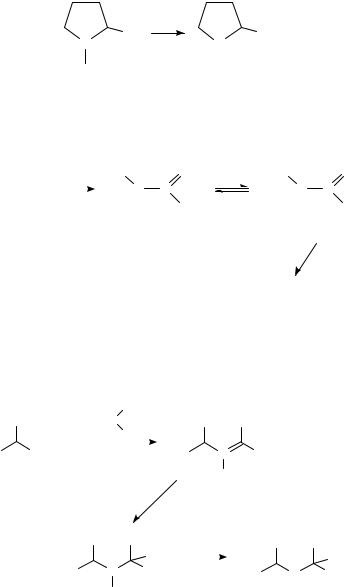
12. Advances in the chemistry of amino and nitro compounds |
535 |
yields 2-phenylpyrrolidine (equation 1)8.
Ph |
N |
Ph |
(1) |
N |
|
||
|
|
H
OH
The formation of secondary amines 3 from hindered N,N-disubstituted hydroxylamines by the action of carbon disulphide is thought to proceed by way of the adducts 1, which are in equilibrium with the betaines 2. These break down into the amines 3 and ‘COS2’, which decomposes into the observed by-products carbon oxysulphide and sulphur9.
|
|
R2 N |
|
+ |
|
|
|
S |
R2 NH |
S |
|
R2 NOH + CS2 |
|
|
O C |
O |
C |
|
|||||
|
|
|
SH |
|
S − |
|
|
|
(1) |
|
(2) |
R2 NH + COS2
(3)
Treatment of hydroxylamines 4 (R1 D cyclohexyl, Ph or 3,4-(MeO)2C6H3) with acetone gives nitrones 5, which are transformed by Grignard reagents R2MgBr (R2 D Me, Et, Bu, Ph or allyl) into the hydroxylamines 6; the latter are converted into the hindered secondary amines 7 by means of carbon disulphide10.
|
|
|
Me |
|
|
|
|
|
|
|
|
|
Me |
|
+ OC |
|
|
Me |
|
|
Me |
|
|
|
|
|
Me |
|
|
|
+ |
|
|
|
|
|
|
|
|
|
|
|
|
|
|
|
|
R1 |
NHOH |
|
− H2 O |
|
R1 |
|
Me |
|
|
||
|
|
N |
|
|
|||||||
|
|
|
|
|
|
|
O − |
|
|
|
|
|
(4) |
|
|
|
+ R2 MgBr |
(5) |
|
|
|
||
|
|
Me Me |
R2 |
|
|
|
|
Me |
Me |
||
|
R1 |
|
|
|
|
|
|
|
R2 |
||
|
|
|
|
|
|
|
|
||||
|
|
N |
Me |
|
|
R1 |
N |
Me |
|||
|
|
|
OH |
|
|
|
|
|
|
H |
|
|
|
|
|
|
|
|
|
|
|
|
|
|
|
(6) |
|
|
|
|
|
|
(7) |
|
|
Tertiary amine N-oxides are rapidly deoxygenated by carbon disulphide11,12. Oximes are reduced to primary amines by titanium(III) chloride in the presence of sodium cyanoborohydride, NaBH3CN13. The combined action of sodium borohydride and a chiral
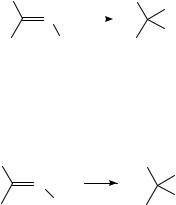
536 |
G. V. Boyd |
amino acid on ketoxime O-alkyl ethers yields optically active primary amines in up to 95% enantiomeric excess14. The chiral reducing agent BH3/( )-norephedrine converted the anti-oxime ethers 8 (R D Me, C8H17, Me3 Si or PhCH2) into the (S)-amine 9 in 92% enantiomeric excess, while the syn-oxime ethers gave the (R)-amine15.
Ph |
|
|
Ph |
|
N |
|
H |
|
|
NH2 |
|
|
|
||
Me |
OR |
|
|
|
Me |
||
|
(8) |
(9) |
|
Fermenting baker’s yeast transformed 2-butanone oxime containing 44% excess of the (E)-isomer into optically active (R)-2-aminobutane in 58% enantiomeric excess. The chiral amine was also obtained in 24% e.e. from the oxime acetate but the oxime methyl ether gave a racemic product (equation 2)16.
Et |
|
Et |
|
|
H |
|
N |
(2) |
Me |
OH |
NH2 |
|
Me |
c. Reduction of amides and cyanides. Amides and cyanides are reduced to amines by the combined action of sodium borohydride and iodine in THF; some examples are shown below (equation 3)17:
PhNHAc ! PhNHEt |
|
PhMeNAc ! PhMeNEt |
|
PhCONH2 ! PhCH2NH2 |
|
PhCH2CN ! PhCH2CH2NH2 |
(3) |
C8H17CN ! C9H19NH2 |
|
PhCN ! PhCH2NH2 |
|
The lithium aminoborohydrides 10 and 11, prepared from the complex BH3. THF by treatment with, respectively, pyrrolidine and diisopropylamine, followed by butyllithium, are safe, powerful reducing agents. Tertiary amides are converted into amines, e.g. N,N-diethyldodecanoamide gives dodecyldiethylamine and N,N-diethylsalicylamide gives diethyl (o-hydroxybenzyl)amine18. A similar reduction of tertiary amides R1CONR2R3
(R1, R2 |
D2 3 |
Me, |
Et, i-Pr |
or Ph; R3 |
D |
H, Et, |
i-Pr |
or PhCH |
) |
to |
the amines |
1 |
by |
means of |
|
|
has |
2 |
|
19 |
. Diborane, |
||
R CH2NR R |
borane/dimethylsulphide |
been reported |
|||||||||
generated from sodium borohydride and boron trifluoride diethyl etherate, converts primary, secondary and tertiary amides into amines in moderate to high yields; lactams give the corresponding cyclic amines20. Sodium borohydride/bis(2-bromoethyl) selenium dibromide (BrCH2CH2)2SeBr2 in THF is a selective reagent for the reduction of secondary amides to secondary amines; primary and tertiary amides are not affected21. Similarly, the combination sodium borohydride/Et2SeX2 reduces amides to amines; for secondary amides the reactivity decreases in the sequence X D I > X D Br > X D Cl .

12. Advances in the chemistry of amino and nitro compounds |
537 |
|||
|
Pri |
|
Pri |
|
N |
Li+ |
N |
Li+ |
|
H3 B− |
|
H3 B− |
|
|
(10) |
|
(11) |
|
|
Only the iodine-containing reagent is capable of reducing primary and tertiary amides22.
High yields of secondary amines are obtained when solutions of nitriles in acetic acid are hydrogenated at room temperature and pressure over a 5% rhodium-on-alumina catalyst (equation 4); hydroxy, ethoxycarbonyl and tosylamino substituents are not affected23.
2 RCN + 5[H] |
|
RCH2 |
CH2 R |
|
(4)
N
H
d. Reduction of azides. Synthetic uses of azides have been reviewed24. Primary amines are produced in good yields when aliphatic or aromatic azides are heated with hydrazine in ethanol in the presence of palladium25; the reduction is also accomplished by methanolic tin(II) chloride26, by sodium borohydride/copper sulphate in ice-cold methanol27, by magnesium and calcium in methanol28, by nickel boride generated in situ from sodium borohydride and nickel chloride in methanol29 and by a borohydride exchange resin/nickel acetate system30.
The benzylic hydrogen atom of alkylarenes is replaced by the azido group on treatment with trimethylsilyl azide in the presence of 2,3-dichloro-5,6-dicyano-1,4-benzoquinone; subsequent hydrogenation yields amines (e.g. equation 5)31.
Me |
|
|
Me |
|
Me |
|
4-MeOC6 H4 CH |
|
4-MeOC6 H4 C |
|
|
4-MeOC6 H4 C |
(5) |
|
|
|
||||
Et |
|
N3 |
Et |
|
NH2Et |
|
The following sequence (equation 6) constitutes a convenient alternative to the conversion of alkyl halides into alkylamines by the Gabriel reaction with potassium phthalimide. In this one-pot procedure, an alkyl bromide RBr (R D Bu, i-Bu, 2-pentyl, 2-octyl, PhCH2CH2, HC C, PhCHDCHCH2, cyclopentyl, cyclohexyl etc.) is treated with sodium azide in benzene in the presence of tetrabutylammonium bromide under phase-transfer conditions. Triethyl phosphite is then added and the resulting iminophosphorane is decomposed to the alkyl amine hydrochloride by adding benzene and hydrogen chloride32.
RBr |
|
RN3 |
+ P(OEt)3 |
RN |
|
P(OEt)3 |
HCl |
RNH2 |
. HCl |
(6) |
|
|
|
|
|||||||
|
− N2 |
|
||||||||
|
|
|
||||||||
|
|
|
|
|
|
|
|
|
|
The action of tin(II) chloride in ethanol/ethyl acetate on the aryl azides 12 (R1 D R3 D F, R2 D NO2, CHO or CO2Me; R1 D NH2, R2 D NO2, R3 D H) leads to the corresponding anilines 1333.
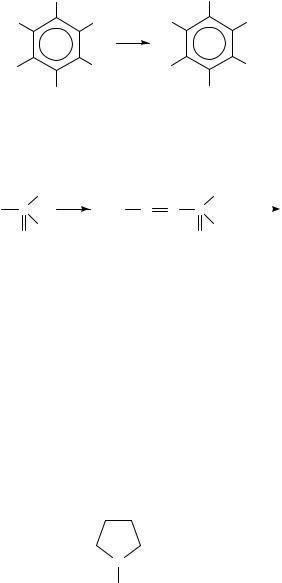
538 |
G. V. Boyd |
|
|
N3 |
|
|
NH2 |
F |
F |
F |
F |
R1 |
R3 |
R1 |
R3 |
R2 |
|
|
R2 |
(12) |
|
|
(13) |
Organolithium or Grignard compounds derived from aryl or heteroaryl halides react with diphenyl phosphorazidate to give labile phosphinoyltriazenes, which on reductive work-up with aluminium hydride afford good yields of aryl or heteroaryl amines (equation 7)34.
OPh |
|
OPh |
||
RM + N3 P |
RNH N N P |
|
|
RNH2 (7) |
|
|
|||
O OPh |
O |
OPh |
||
A one-pot procedure for the conversion of alcohols into alkylamines is by treatment of the former with hydrazoic acid in the presence of triphenylphosphine and diisopropyl azodicarboxylate; addition of triphenylphosphine to the resulting azide gives an iminophosphorane, which is hydrolysed to the alkylamine by water (equation 8)35.
|
|
|
|
|
CPPh3 |
|
|
|
H2O |
|
|
|
ROH |
C |
HN3 |
! |
RN3 |
! |
RN |
D |
PPh3 |
! |
RNH2 |
8 |
|
|
|
|
|
2 |
|
|
3 |
|
|
|||
|
|
|
|
|
N |
|
|
|
|
Ph PO |
|
|
2. By alkylation and arylation of amines and azides
Aromatic amines RNH2 (R D Ph, by triphenylbismuth in the presence yield diarylamines RNHPh. Butylamine
2-MeC6H4 or 4-MeOC6H4) are phenylated of 0.5 equivalent of copper(II) acetate to yields a mixture of N-butylaniline and N-
butyldiphenylamine in this reaction and piperidine gives N-phenylpiperidine36. A similar alkylation of the secondary amines pyrrolidine, piperidine and morpholine with trimethylbismuth or tris(2-phenylethyl)bismuth in the presence of copper(II) acetate affords tertiary amines, e.g. 14. The reaction proceeds by way of transient pentavalent bismuth compounds37.
N
CH2 CH2 Ph
(14)
The direct high-pressure amination of ethylene with ammonia to give ethylamine occurs in the presence of acidic zeolite catalysts such as H-elinoptilolite, H-erionite or H-offretite38. Primary amines R1NH2(R1 D Bu, cyclohexyl, PhCH2, Ph or Ar) have been monoalkylated by reaction with di-t-butyl dicarbonate, followed by successive treatment of
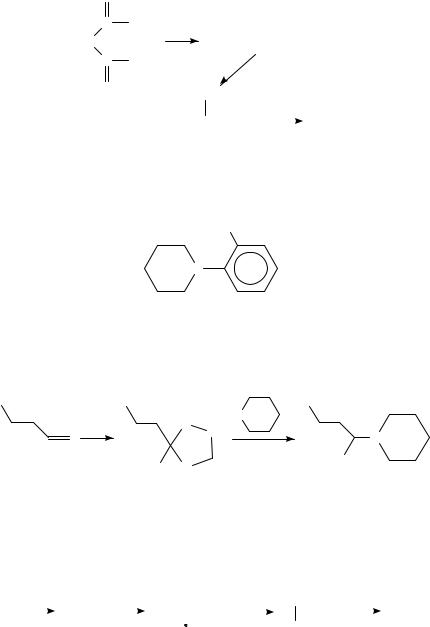
12. Advances in the chemistry of amino and nitro compounds |
539 |
the product with sodium hydride, an alkyl halide R2 X (R2 D Me, Et, Pr, Bu,CH2DCHCH2 or PhCH2) and dilute hydrochloric acid (equation 9)39.
O |
|
|
|
|
|
|
|
|
|
|
|
|
|
C |
OBut |
|
O |
|
|||||||||
|
|
|
|
|
|
|
|
|
|
||||
R1 NH2 + O |
OBut |
R1 NHC |
|
|
|
|
|
OBut |
(9) |
||||
|
|
||||||||||||
|
|
|
|
|
|||||||||
C |
|
|
|
+ R2X |
|||||||||
|
|
|
|
|
|
|
|
||||||
O |
O |
|
|
|
|
|
|
|
|
|
|
||
|
|
|
|
|
|
|
|
|
|
|
|||
|
R1 R2 NC |
|
|
|
OBut |
HCl |
R1 R2 NH . HCl |
||||||
|
|
||||||||||||
|
|
|
|
|
|||||||||
Lithium derivatives of dialkylamines react with aryl methyl ethers in refluxing THF by substitution to afford N-aryldialkylamines (equation 10). Similarly, lithium piperidide and veratrole give N-(2-methoxyphenyl)piperidine (15)40.
R2NLi C MeOAr ! R2NAr |
10 |
MeO
N
(15)
A method for the conversion of alkenes into tertiary amines is exemplified by the formation of N-(3-phenylpropyl)piperidine when the ozonide of 4-phenylbut-1-ene is heated with piperidine in the presence of 4 A˚ molecular sieves (equation 11). The carbon atom which is eliminated appears as piperidinium formate41.
Ph |
Ph |
|
Ph |
|
|
O |
HN |
|
O3 |
|
|
|
O |
N |
|
|
|
|
H
H O
11
Hindered di-t-alkylamines RNHBut (R D t-Bu, t-octyl or 1-adamantyl) have been synthesized from t-alkylamines as follows. Reaction with peracetic acid gave the nitrosoalkanes RNO, which were treated with t-butyl radicals, generated from t- butylhydrazine and lead(IV) oxide, to yield t-butyloxyhydroxylamines. Reduction with sodium naphthalide in THF gave the products (equation 12). The di-t-alkyl-amines are inert to methyl iodide and dimethyl sulphate but can be alkylated by methyl fluorosulphonate42.
|
|
|
|
|
t-Bu • |
|
RN |
|
But |
|
|
t-Bu • RN |
|
But |
2[H] |
||||
|
|
|
|
|
|
|
|
||||||||||||
RNH2 |
|
RN |
|
O |
|
|
|
|
|
|
|
|
|
|
|
|
|
|
RNBut |
|
|
|
|
|
|
|
|
|
|
|
|
|
|||||||
|
|
|
|
|
|
|
|
|
|
|
|
|
|
|
|
||||
|
|
|
|
|
|
|
|
O |
|
|
|
|
|
OBut |
|
H |
|||
12

540 |
G. V. Boyd |
Alkyl halides are converted into the tertiary amines RNMe2 (R D Me, Et, Bu, PhCH2, CH CCH2 etc.) by the action of acetaldehyde N,N-dimethylhydrazone, followed by hydrolysis of the product with methanolic potassium hydroxide (equation 13)43.
+
RX + CH3 CH  NNMe2
NNMe2  CH3 CH
CH3 CH  NNMe2
NNMe2  RNMe2
RNMe2
(13)
R X −
Tertiary alkyl chlorides, which cannot be aminated directly, react with trimethylsilyl azide under tin(IV) chloride catalysis to yield the corresponding alkyl azides. The crude products are directly converted into t-alkylamine hydrochlorides by consecutive treatment with triethyl phosphite and gaseous hydrogen chloride (equation 14)44.
|
|
|
|
|
CP(OEt)3 |
|
|
|
|
CHCl |
|
|
|
|
||
|
|
|
|
|
|
|
|
CH2O |
|
|
|
|
||||
RCl |
C |
Me3SiN3 |
! |
RN3 |
! |
RN |
D |
P(OEt)3 |
! |
RNH2 |
Ð |
HCl |
||||
|
|
|
|
2 |
|
|
|
D |
P(OEt) |
3 |
|
|
||||
|
|
|
|
|
N |
|
|
|
|
O |
|
|
|
|
|
|
(14)
N-Methyl-N-(2-perfluoroalkyl)ethylamines 17 (R D C4F9, C6F13 or C8F17) were prepared from the azides 16 by sequential reaction with triphenylphosphine, methyl iodide and aqueous potassium hydroxide45.
|
CPPh3 |
|
|
|
(i) MeI |
|
|
|
|
D |
|
(ii) KOH |
|
||
RCH2CH2N3 |
!2 |
RCH2CH2N |
PPH3 |
! |
RCH2CH2NHMe |
||
(16) |
|
N |
|
|
|
|
(17) |
|
|
|
|
|
|||
|
|
|
|
|
|
||
3. By modifications of the Gabriel synthesis
A number of syntheses of primary amines from reagents other than potassium phthalimide has been described (Review: Reference 46). Sodium diformylamide is a convenient substitute. It is alkylated in DMF or acetonitrile by adding an alkyl halide or tosylate and the products are decomposed by adding dilute hydrochloric acid to give alkylamine hydrochlorides in excellent yields (equation 15)47.
O |
O |
|
|
|
|
HC |
HC |
+ HCl |
|
|
|
N − Na+ |
+ RX |
NR |
+ 2H2 O |
RNH2 HCl |
(15) |
|
− 2HCO2 H |
||||
HC |
HC |
|
|
||
|
|
|
|||
O |
O |
|
|
|
|
Diethyl N-(t-butoxycarbonyl)phosphoramidate 18 is obtained from diethyl phosphoramidate by successive treatment with oxalyl chloride and t-butyl alcohol. It forms a stable non-hydroscopic sodium salt, which reacts with a variety of alkyl halides in benzene in the presence of tetrabutylammonium bromide under phase-transfer conditions to give the corresponding N-alkyl derivatives. The latter are cleaved by hydrogen chloride in benzene to yield amine hydrochlorides (equation 16)48.
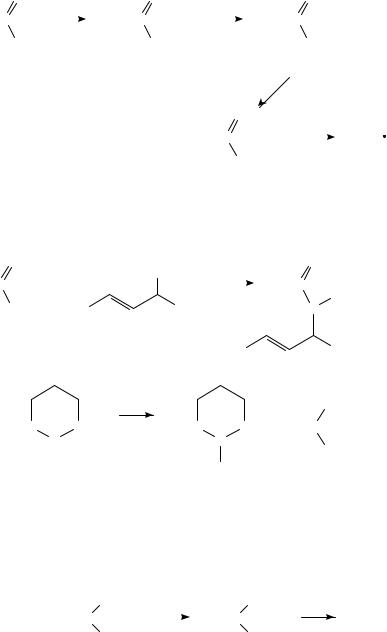
|
|
|
12. Advances in the chemistry of amino and nitro compounds |
|
|
541 |
|||||||||||
|
|
|
O |
|
COCl |
|
O |
|
O |
|
|
|
|||||
|
|
|
|
|
|
|
|
|
|
+ ButOH |
|
|
|
|
|
|
|
(EtO)2 P |
|
COCl |
|
(EtO)2 P |
(EtO)2 P |
|
|
|
|||||||||
|
|
|
|
|
|
|
|
|
|
||||||||
|
|
|
NH2 |
|
|
|
|
|
NCO |
|
NHCO2 But |
||||||
|
|
|
|
|
|
|
|
|
|
|
|
(18) |
|
|
(16) |
||
|
|
|
|
|
|
|
|
|
|
|
|
|
|
|
|
|
|
|
|
|
|
|
|
|
|
|
|
|
|
(i) NaOH |
|
|
|
||
|
|
|
|
|
|
|
|
|
|
O |
(ii) RX |
|
|
|
|||
|
|
|
|
|
|
|
|
|
|
|
|
|
|
|
|
||
|
|
|
|
|
|
|
|
|
|
(EtO)2 P |
|
|
|
|
RNH2 HCl |
||
|
|
|
|
|
|
|
|
|
|
|
|
|
|||||
|
|
|
|
|
|
|
|
|
|
NRCO2 But |
|
|
|
||||
|
The sodium salt of 18 condenses with allylic acetates (E)-R1 CHDCH |
|
CHR2OAc |
||||||||||||||
(R |
1 |
D |
Ph or |
C7H15; R |
2 |
D Me or C7H15) in THF |
|
|
|
a catalytic |
|||||||
|
|
in the presence of |
|
||||||||||||||
amount of tetrakis(triphenylphosphine)palladium(0) to give doubly protected allylic amines (equation 17)49.
O |
|
OAc |
|
|
O |
|
|
|
(EtO)2 P |
+ |
|
(EtO)2 P |
|
|
|||
|
|
|
|
t |
||||
|
|
|
|
|||||
− |
|
|
|
− NaOA c |
|
CO2 Bu |
||
R1 |
R2 |
|
|
|
(17) |
|||
NCO2 But |
|
|
N |
|
||||
Na+ |
|
|
|
|
|
|
|
|
|
|
|
|
R1 |
|
R2 |
|
|
|
|
|
|
|
|
|
CO2 But |
|
Me2 Si − |
SiMe2 |
Me2 Si |
SiMe2 |
HN |
|
|
||
N |
|
|
|
N |
|
CO2 But |
|
|
K + |
|
|
R |
|
|
|||
|
|
|
|
|
|
|
||
(19) |
|
|
(20) |
|
|
(21) |
|
|
The potassium compound 19 is readily transformed into 20 (R D alkyl) by the action of alkyl halides. The products are converted into salts of alkylamines RNH2 by acidic hydrolysis50. Uses of di-t-butyl imidodicarboxylate (21) have been reviewed46. Treatment of formamide with ‘di-t-butyl dicarbonate’ 22 gives the unstable formyl compound 23, which yields 21 by the action of 2-diethylaminoethylamine (equation 18)51.
CO2 But |
|
|
CO2 But |
HCONH2 + O |
|
HCON |
(21) |
|
|||
CO2 But |
|
|
(18) |
|
|
CO2 But |
|
(22) |
|
|
(23) |
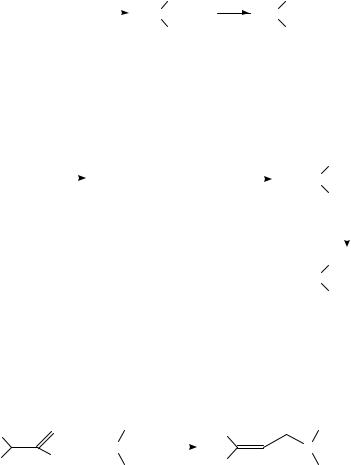
542 |
G. V. Boyd |
The analogue, t-butyl methyl iminodicarboxylate 25, is obtained by the reaction of methanol with t-butyl oxamate (24) in the presence of lead tetraacetate. Its stable non-hygroscopic potassium salt is converted into alkyl derivatives 26 by the action of alkyl halides such as butyl bromide, allyl bromide, propargyl bromide and ethyl bromoacetate. The products are hydrolysed by trifluoroacetic acid to salts of primary amines, whereas
molar sodium hydroxide gives the protected amines RNHCO2 But52 .
|
CO2 But |
|
CO2 But |
CO2 But |
|
|
|
HN |
RN |
|
|
|
||
|
CONH2 |
|
CO2 Me |
CO2 Me |
(24) |
(25) |
(26) |
||
A very similar reagent is benzyl t-butylimidodicarboxylate 27, which is prepared from benzyl alcohol and benzoyl isocyanate, followed by ‘exhaustive acylation’ with t-butoxycarbonyl chloride. Aminolysis of the resulting triacylamine yields 27. Treatment of the sodium salt of compound 27 with alkyl halides, followed by hydrolysis, gives primary amines53.
HOCH2 Ph |
|
|
|
CO2 But |
|
|
|
+ ClCO2 But |
|||
+ |
|
|
|||
|
PhCONHCO2 CH2 Ph |
|
PhCON |
||
|
|
||||
PhCONCO |
|
|
|
CO2 CH2 Ph |
|
|
|
|
|
||
|
|
|
|
|
NH3 |
|
|
|
|
|
|
|
|
|
|
|
|
|
|
|
|
CO2 But |
|
|
|
|
|
HN |
|
|
|
|
|
CO2 CH2 Ph |
|
|
|
|
(27) |
||
The synthesis of various allyl derivatives of di-t-butyl iminodicarboxylate 21 from its lithium salt and allyl acetates under Pd(0) catalysis has been described. Rearrangements have been observed in some reactions, e.g. equation 19. The products are cleaved to t-butoxycarbonylamines by trifluoroacetic acid at room temperature; dilute hydrochloric acid removes the second protecting group54.
Me |
|
|
CO2 But |
|
Me |
CO2 But |
|
+ |
|
|
|||
|
+ |
Li |
−N |
|
N |
(19) |
|
|
|||||
Me |
OAc |
|
CO2 But |
|
Me |
CO2 But |
|
|
|
|
|
||
4. From alcohols
A convenient one-pot procedure for the conversion of alcohols into primary amines has been reported. The alcohol is converted into the corresponding alkyl halide by the action of bromotrichloromethane/triphenylphosphine and the product is treated successively with sodium azide, triethyl phosphite, hydrochloric acid and sodium hydroxide (equation 20)55, cf. equation 14.
